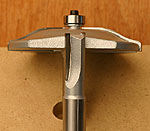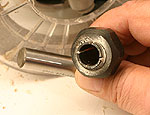This is a Veteran Owned site
Router Bit Speeds
Fallacies, Safety and "The Sweet Spot"Text & Photos by Tom Hintz Note: The routers and bits pictured in this story were used because I had them, not because they had a balance problem. All of the bits used in this story run perfectly at the proper RPM!A frequent question at NewWoodworker.com regards router bit speed - specifically, how fast to turn a specific bit. Today, most routers are equipped with variable speed controls that allow reducing RPM to spin larger bits than could be safely done with single speed models. The ability to control RPM also increases the need to understand how speed relates to bits, performance and safety. Equipment ConditionBecause of the speeds generated by routers at even their slowest settings, it is crucial that bits, the routers themselves and all related equipment be in perfect condition. The tremendous forces generated throughout a routers speed range means there is no such thing as an acceptable level of damage. If the clear and present danger of operating a suspect router or bit does not sound dangerous, you simply do not understand the problem. Dangerous AdviceRecently I came across a frightening question/answer sequence on an Internet woodworking forum. A novice woodworker with a single-speed (rated at 23,000 RPM) router questioned using a large bit that came with a warning not to exceed 18,000 RPM. A veteran member of the forum advised, "Router bit manufacturers build in a large safety factor, you can spin that bit way faster than that!" The problem is that this "safety factor" is a fallacy and a potentially dangerous one if believed.
This piece of advice, and there have been other equally scary exchanges, could easily have put the novice at risk. Fortunately, I was able to refer the novice posing the question to a manufacturer's tech line where he was given legitimate advice that, not surprisingly, directly contradicted the assurance offered by the "veteran" on the forum. When in doubt, use the tech lines most manufacturers offer. If they do not respond, you need a new router bit manufacturer. Mystery SpeedsAn unfortunate number of router bit manufacturers do not see the benefit of providing clear RPM recommendations with their bits, in their instructions (if they exist) or on their web sites. This appears to be changing, albeit slowly. One of the best in this regard is David Venditto, owner of Infinity Cutting Tools in Clearwater, Florida (www.infinitytools.com). Venditto prints a basic speed/bit size chart on the back of the pouches Infinity bits come in. He also provides a growing number of downloadable instruction sheets on the use and setup of his bits. In addition, most of the larger-diameter bits in the Infinity Tools catalog include the maximum recommended speed in the product description. Venditto tells Newwoodworker.com that providing bit speed information for his products will grow beyond what is already provided. Speed and Bit Diameter
Recommended router speeds generally decrease as bit diameter increases. It is important to understand that router speed is measured as shaft RPM but the outer edges of a bit, though turning at shaft RPM, attain much higher speeds because the distance traveled through each revolution increases dramatically as diameter grows larger. Here is a little math router manufacturers use when determining the all-important speed of the outer edges of bits: Circumference = pi X diameter 1" circ. = 3.1415 * 1 = 3.1415 ---> 3.1415in * 18000rpm = 56547in/min or 4712.25 ft/min or 53.55 mph 2" circ. = 3.1415 * 2 = 6.2830 ---> 6.2830in * 18000rpm = 113094in/min or 9424.50 ft/min or 107.10 mph 3" circ. = 3.1415 * 3 = 9.4245 ---> 9.4245in * 18000rpm = 169641in/min or 14136.75 ft/min or 160.64 mph As you can see from the above equations, a bit 1" in diameter, moving at 18,000 rpm is traveling at 53.55 mph at its maximum diameter. Likewise, a bit of 3" in diameter, also spinning at 18,000 rpm is traveling at 160.64 mph at its maximum diameter. So, lets take the example of someone using a 1" diameter straight bit at 18,000 rpm and changed to a 3" diameter roundover bit but did not decrease the router RPM. This person has, in effect, tripled the speed at which the tool is spinning just by keeping their set-up constant. Weight, Speed and DistanceThe effects of weight multiply as its distance from the shaft centerline increases. These forces can be substantial, allowing a perfectly balanced bit to "vibrate" due to tiny amounts of runout in the router, play in the bearings or looseness in its mounting.
The length of a router bit can have similar effects as a large diameter. A long bit positions weight farther from the collet meaning a tiny amount of runout can be greatly magnified because the end of the long bit swings through a much wider circle than a shorter bit does. Again, the result can be vibration, poor cut performance and even reduced safety from a bit that has no problems itself. These problems with long bits catch many woodworkers by surprise. Because extended length bits are usually well under 1" in diameter, basic speed charts suggest they can be run at full RPM. However, their overall length often means reducing RPM is necessary to keep them running smooth and producing the best cut possible. Whenever I use a long bit, I look for the "Sweet Spot" in RPM as described later in this article. In nearly every case, the optimum RPM for my bit/router/table combination is substantially below the maximum indicated by standard speed charts. Accumulated ProblemsEncountering an actual balance problem with mid to high-quality routers or bits is an increasingly rare occurrence. Modern manufacturing equipment and techniques are extremely precise, as are balancing and testing procedures. When a vibration is encountered, particularly one that appears only at higher RPM, it is important to consider that the problem may be the result of multiple but individual factors manifesting themselves as a vibration. The bit is usually suspected but may not be the cause. Tiny amounts of play at the router motor shaft, between the router motor and its handle assembly or even whatever device connects the router to a router table can add up to a vibration. Large diameter or long bits tend to reveal these problems sooner than small-diameter bits and reducing RPM may stop the vibration. It is important to try to locate the source of the problem anyway as it could grow worse during use. Maximum May Not Be Optimum
Too often, woodworkers interpret a maximum safe RPM recommendation as THE operating speed. However, the best RPM setting for your combination; bit, router and mounting, will often be somewhere below the maximum. It seems that cuts-per-inch are too often related to pure router RPM - more RPM equals more cuts-per-inch which usually improves the quality of the cut. While this is essentially true, bit speed is less of a controlling factor on cuts-per-inch than is feed rate, or how fast the wood is passed across the bit. Slowing feed rate slightly multiplies the number of cutter presentations to each inch of wood dramatically. Keep in mind that too fast a feed rate can induce chipping and tear out and an excessively slow rate of feed can result in heat buildup and burning. Balancing reasonable bit speed and feed rate is the safest way to achieve the cuts-per-inch that works best for the task at hand. The Sweet Spot
I have found that most bits have a "sweet spot," an RPM at which a bit runs smoothest and produces the best cut. If you use more than one router, the sweet spot might be slightly different on each machine. While often under the suggested maximum speed, sometimes by a few thousand RPM, it is not uncommon to find the sweet spot close to the upper RPM limits with high-quality bits that often feature ultra-precise machining and balancing. First, check the bit, collet and router for signs of damage. I simply will not run a bit that has any visible damage or is suspect in any way. The potential consequences of a bit failure cannot be taken lightly. Either have a damaged bit evaluated by the manufacturer or replace it. There are no reasonable alternatives. To find the sweet spot, install the bit, set the router to its lowest speed and then turn it on. Gradually increase RPM towards the maximum recommended by the manufacturer. At some point before reaching maximum speed, you may feel the beginnings of a vibration, often a "buzzing" sensation, that signals where that bit and router combination begins to lose stability. Reduce RPM slightly until the vibration stops and shut down the router. Note the speed control setting and compare that to the maximum RPM recommended by the manufacturer. If the vibration stopped within a few thousand RPM of the maximumimum, I consider that to be the sweet spot and use it as my operating speed for that bit and router combination. If the vibration began more than 5000 RPM below the maximum, it's time to investigate. The first thing to do is be sure the bit, collet and collet nut are free from dust, residue or other contamination that could induce an alignment error. Surprisingly small amounts of debris can instigate a vibration and poor cut performance. Regardless if you see contamination or not, clean the bit and collet and try it again. If the vibration returns stop the router, loosen the collet, turn the bit 180-degrees and then tighten the collet again. Repeat the test and note where or if the vibration returns. If the vibration is gone or its onset is at a significantly different RPM, that could mean that the bit or router shaft are slightly bent or out of balance and turning the bit 180-degrees essentially counterbalanced that problem. Finding this condition is very rare but remains worth investigating. Once the sweet spot for a particular bit has been identified, record that RPM so it can be referred to the next time it is used. If the bit begins to vibrate at or below its normal sweet spot RPM, something has changed and it's time for you to investigate. Often the culprit in these cases is nothing more than a little buildup on the bit in which case a simple cleaning is the cure. Routers are valuable and often-used tools in today's woodworking shop. Taking a little time to find the best operational speed for your router and bit combinations will keep them running smoother and longer, not to mention safer. |
||||||||||||||||||||||||
Do you have a comment about this page? - Email Me!
|
||||||||||||||||||||||||
All written, photographic and drawn materials are property of and copyright by NewWoodworker.com LLC 2000-2019. Materials may not be used in any way without the written permission of the owner.






